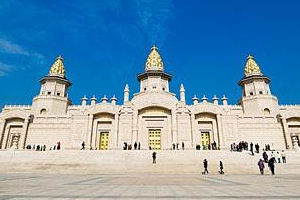Buddhism and Music
In most countries music has developed in close affinity with religious observances. But the Theravada ideology does not encourage sensual arts like music and dancing. That when Buddhism was not only a religion. but the way of the life for the people. such performing arts received little patronage from the temple. The Buddhist clergy, who constituted the main literati of the country. Declined to praise the role of the musician or musical content in their documents, but on the country performing arts were treated as activities to be shunned by the bhikkhus and the even by the devout laymen. ( Sarachchandra, 1982, p9 ) Buddhism has no codification of any date pertaining to music and dancing in its worship. Even the chanting of the Buddhist sutras should strictly be non – musical ( Kulathilake , 1982 pp 19 – 30 ) such steps were considered necessary to maintain the purity of Buddhist discipline and orthodoxy of the temple. The annihilation of Buddhism in
In spit of all the music and dancing have develop as falk arts among the Buddhist but not in the proper easuhevie aspects. When the Buddhist temple became the intrincincallty impotent religious as well as the social central of activity to the village dancing with singing development as most of the worship in the sub religions. Meanwhile the orthodoxy of the Buddhist temple licensed only that limited repertoires of these arts required for the exigencies of the temple festivals ( senevirathne 1973 )
We shall now see how the sub – religions which was patronized by the Buddhist themselves became the main institution of performing arts like dancing and music , of which the former has today gained international recognition.
The social religious cultural
The Musical aspect of the Sri Lankan pirith sajjayana.
02. Pirith is important part of the Buddhist sajajayana. Sajajayana means loudly expression and group reciting. pirith is consider as giving of the safe guard, protection , prevention and emotive consolation by the reciting Buddhist Suthras. although this reciting is not established with the musical expectations there are reasonable musical aspects of the pirith sajajayana. Then pirith sajajayana is a very respectable role among the Sri Lankan folk lives. Prith sajajyana is based on suthras which adapted from Thripitaka. Those suthras as followings..
01. Maha Magala
02. Rathna
03. Karaneeyameththa
04. Dhadaggha
05. Parabhawa
06. Kaseebajathwaja
07. Meththanisansa
08. Dhammachakka
09. Maha samaya
10. Girimaanda
Gathas are recited in the pirith sajajyana which is founded in viritha. Viritha is the meter of gatha. Vritha is considered as combining of short letters and sustainable letters. It called lagu and guru.
There can be seen ‘thristub’ and ‘anustub’ virith in the pirith sajajyana. Those virith created in the Vedic period. When recites with those instructor (virith ) it gives some musical stimulations.
Eg:
i. ( Anushtub virith )
Bahu Dewa manushasacha ………
mangalani achainayun…….
Akaknkaman sothanan….
Bauhi mangala muththman
ii. There are four kind of parts in the maha piritha according to reciting styles. Here we do concentrated and attention to it. Because , it takes a major roll in the musical behavior.
Approach
Reciting of suththra
Duets
End of reciting
These reciting styles are further the distinguished as extension of the Sinhala music tradition. as a results of that there are some musical scales in the Sri Lankan music. Such Falk musical scales are nourished and influenced by the pirith sajajayana. Sri Lakan pirith sajajayana is peculiar to its own way. when it comes to end allways it locates beyond one octave that even to very difficult understand to musician. Today some of Sri Lankan musicians try to explore musical combination of pirith sajajayana and allready they have been realized north Indian rag reflection in the pirith. Specially they see some similar points between north Indian music and pirith chanting.
Eg:
rag : thodhi
The suthras which belongs to the pirith are fictioned by the pali. The long usage of Sri Lankan Society now it became to independent recitting styles and a devoting way. Late Mr . C. De.S. kulathilaka who is musicologist in the
Here are some suggtions for the innovative development of the music. Those are as following:
01. Identifying tonal performs of the pirith sajajayana.
02. Criticizing of the sajajayana scales according to ethnomusicological and musicological discipline.

欢迎投稿:lianxiwo@fjdh.cn
2.佛教导航欢迎广大读者踊跃投稿,佛教导航将优先发布高质量的稿件,如果有必要,在不破坏关键事实和中心思想的前提下,佛教导航将会对原始稿件做适当润色和修饰,并主动联系作者确认修改稿后,才会正式发布。如果作者希望披露自己的联系方式和个人简单背景资料,佛教导航会尽量满足您的需求;
3.文章来源注明“佛教导航”的文章,为本站编辑组原创文章,其版权归佛教导航所有。欢迎非营利性电子刊物、网站转载,但须清楚注明来源“佛教导航”或作者“佛教导航”。



